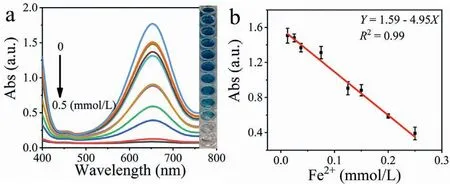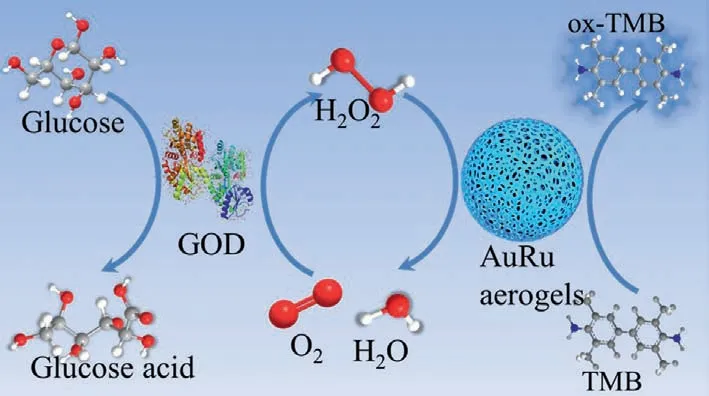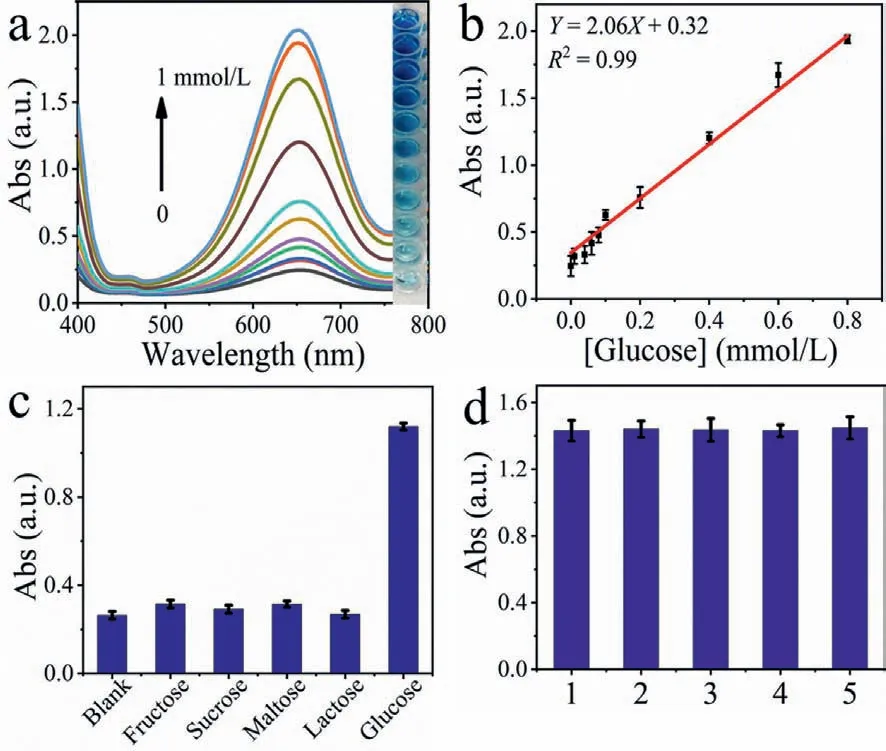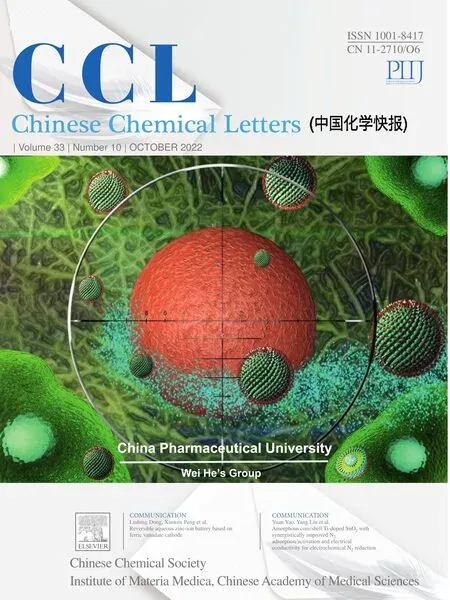Bimetallic AuRu aerogel with enzyme-like activity for colorimetric detection of Fe2+ and glucose
Rongxin Xu,Ziyu Wng,Siqun Liu,He Li,*
a College of Optoelectronics Technology,Chengdu University of Information Technology,Chengdu 610225,China
b School of Chemistry and Chemical Engineering,University of Jinan,Ji’nan 250022,China
Keywords:Au-Ru aerogels Multifunctional nanozyme Peroxidase-mimicking Oxidase-like activity Colorimetric detection
ABSTRACT Aerogels have become a hot topic of research due to their extremely low density and special interconnected structure as well as their enzyme-like activity.The development of new multifunctional nanoenzyme aerogels with high activity and good stability is still a considerable challenge.In this paper,AuRu aerogels with peroxidase and oxidase activities were synthesized using a simple one-step method and successfully used to construct colorimetric sensors for the detection of Fe2+ and glucose based on their enzyme-like activities.Furthermore,we are fortunate to find that AuRu aerogels have good photothermal properties.This suggests that AuRu aerogels can be used not only for in vitro testing but also for promising applications such as disease treatment.
Size,surface morphology and structural composition affect the optical,electronic,magnetic and catalytic properties of nanomaterials,especially precious metal nanomaterials [1-6].For example,Jiang’s team induced the synthesis of porous mesoporous nanospheres with simple active agents,which can significantly increase their specific surface area,increase active sites,reduce mass transfer,and play a significant role in electrochemical catalysis [7].The unique method of bimetallic nanomaterials such as PdCu increased its stability and selectivity in electrocatalytic reactions due to the combination of electronic effects and nanostructure effects,providing a new idea for the field of catalysis [8].In addition to improving the catalytic performance of nanomaterials through specific methods,searching for new functions of nanomaterials has also become a research hotspot [9-13].Miao’s team found that PtPdCu nanomaterials simultaneously exhibited peroxidaselike,oxidase-like,catalase-like,and ferroxidase activities,and performed well in detecting Fe2+and evaluating antioxidant capacity[14].It has proven to have good potential for environmental and bio-detection,catalysis and other applications.Compared with natural enzymes,the adjustable catalytic activity,flexibility of composition and structure design of these nanoenzymes,stability to harsh environments,and excellent biocompatibility have huge application prospects.
Inspired by the above,we hope to design a nanostructure that not only has the properties of multiple enzymes at the same time but can also be used in many fields.In the research of noble metal nanomaterials,especially gold-based materials,smaller gold nanomaterials can completely contact the substrate and exhibit good enzyme-like activity,which is usually related to its large specific surface area [15-18].For instance,He’s team found that AuPt nanostructures showed excellent peroxidase and oxidase activities at the same time [19].Metal Ru has attracted wide attention due to its good peroxidase-like activity [20-23].He’s team synthesized a new type of nanoenzyme with excellent peroxidase-like properties Ru-MOGs and broadened the application of metal gels in the fields of biocatalysis and bioanalysis [20].
Especially,metal aerogels have attracted extensive research interest due to their low density,interconnected pores,high proportion of surface and self-supporting structure [24-27].Therefore,a simple method was proposed to prepare low-density 3D interconnected nanostructured AuRu aerogels with peroxidase-like and oxidase-like activities.Iron is one of the most important trace elements in the human body and is involved in a wide range of physiological activities.However,imbalances in the iron content of cells can lead to many diseases such as iron deficiency anemia,renal tubular cytotoxicity and abnormal liver function [9,28].Therefore,rapid and accurate determination of Fe2+levels is of great importance.Glucose is an important energy supplier and essential substance in the body and plays an essential role in human life.Glucose levels in the body are thought to be associated with various diseases,such as diabetes,hypoglycemia,and metabolic disorders[29,30].There is an urgent need to develop a rapid,accurate,and effective method to detect glucose.Based on the good oxidase-like activity of AuRu aerogels,we successfully constructed a Fe2+colorimetric detection platform.The platform not only has a low detection limit and short detection time but also can directly observe color changes with the naked eye.Furthermore,based on the excellent peroxidase-like activity of AuRu aerogels,we combined it with natural glucose oxidase to construct a glucose colorimetric detection sensor as shown in Scheme 1.Fortunately,we also found that AuRu aerogels exhibit good photothermal performance under 808 nm laser irradiation.Therefore,the synthesized AuRu aerogels are promising for environmental testing,biological testing,andin vivotreatment.

Fig.1.(a) SEM image and corresponding digital photograph (inset).(b) TEM image,(c) HRTEM image,(d) SAED pattern of AuRu aerogels.(e) HAADF mapping images for Au,Ru,B and N,respectively.
The AuRu aerogels were synthesized by a simple one-step hydrothermal method.Firstly,scanning electron microscope (SEM)and transmission electron microscope (TEM) characterized the morphology and structure of the synthesized AuRu aerogels.As shown in Fig.1a,AuRu aerogels were composed of many interconnected porous nanostructures,which could increase mass transfer and surface area.Furthermore,the inset of Fig.1a showed that the density of AuRu aerogels was extremely low.From the TEM image of Fig.1b,AuRu aerogel has a clear 3D network-like nanowire structure.Furthermore,the lattice fringes in the HRTEM image (Fig.1c) and the obvious diffraction rings in the SAED pattern (Fig.1d) confirmed the polycrystalline structure of the AuRu aerogel.In addition,HAADF-STEM-energy dispersive spectroscopy(EDS) mapping images provided basic elements distribution of Au,Ru,B,N (Fig.1e).
As shown in Fig.S3a (Supporting information),a hysteresis loop was observed in the adsorption-desorption isotherm of N2,confirming the mesoporous structure of the prepared AuRu aerogels.Furthermore,its average pore size was 27 nm and the BET surface area was 35.5723 m2/g.The crystal structure of the AuRu aerogels nanowire network was further verified by X-ray powder diffraction (XRD).From Fig.S3b (Supporting information) the typical diffraction peak of AuRu aerogels was located between the standard Au (JCPDS No.65-2870) and Ru pattern (JCPDS No.37-1227),which was a typical face-centered cubic structure.X-ray photoelectron spectroscopy (XPS) was further used to study the composition of materials and the valence changes of surface atoms.Both Au(Fig.S3c in Supporting information) and Ru (Fig.S3d in Supporting information) in AuRu aerogels showed metallic state and oxidation state,which were consistent with the result mentioned above.
The oxidase-like activity detection of AuRu aerogels was carried out in the absence of H2O2.As shown in Fig.S4a (Supporting information),The AuRu aerogels showed a more pronounced change in absorbance compared to the Ru NPs,indicating a greater oxidaselike activity.To further demonstrate the origin of the oxidaselike activity of AuRu aerogels,an EPR experiment was carried out.As shown in Fig.S4b (Supporting information),a set of obvious absorption peak signals of 1:1:1:1 appeared,which confirmed the production of O2·-during the reaction.To further investigate the catalytic mechanism of AuRu aerogels,we have explored the AuTu aerogel-TMB system intermediate using free radical scavengers such as AA andp-benzoquinone.Fig.S4c (Supporting information) further confirmed that the main free radical produced by AuRu aerogels during oxidase-like activity is O2·-.In addition,the effects of pH (2-6),temperature (20-60 °C) and K+concentration (0.5-5 mmol/L) on the enzymatic activity of AuRu aerogels were further studied.It can be seen from Fig.S4d (Supporting information) that when the pH was 4,the AuRu aerogels showed the best activity.AuRu aerogels also showed the best enzyme activity at 40°C,which was close to the temperature of the human body,indicating that the materials were expected to be further used forin vivotreatment (Fig.S4e in Supporting information).It can be observed from Fig.S4f (Supporting information) that with the gradual increase of K+concentration,the absorbance was unchanged,which indicated that the ions do not affect the oxidase-like activity of the AuRu aerogels.To compare the oxidase-like activity of AuRu aerogels more intuitively,the kinetic experiment with TMB as a substrate was carried out (Figs.S4g and h in Supporting information).TheKmvalue of AuRu aerogel was as low as 0.546 mmol/L,indicating that AuRu aerogel had a strong affinity for TMB and high oxidase activity.
In the process of competitive reaction,when other molecules or ions competed with the chromogenic substrate for oxidation,the latter’s color development can be inhibited.Inhibition of the degree of change of chromogenic substrates could be used for selective detection [31,32].Therefore,inspired by the above,we designed a Fe2+detection platform based on the AuRu aerogels oxidase-like activity.To prove that Fe2+undergoes a competitive oxidation reaction during the reaction to produce Fe3+instead of other reactions,salicylic acid was chosen as the color developer for the experiment.As shown in Fig.S5a (Supporting information),when AuRu aerogels were added to the salicylic acid and Fe2+system,a unique characteristic peak was observed at 525 nm,which is typical of Fe3+-salicylic acid complexes [14,31].Therefore,the principle of the AuRu aerogel colorimetric detection Fe2+detection platform was: Based on the activity of the AuRu aerogel-like oxidase,oxygen dissolved in the buffer was broken down into superoxide radicals and TMB was oxidized by strong radicals to blue ox-TMB.When Fe2+was added to the system,it competed with TMB for oxygen and was oxidized to Fe3+,resulting in the production of less ox-TMB,indicating that colorimetric detection of Fe2+by changes in absorbance was feasible.
As expected,the absorbance and color of the TMB color reaction catalyzed by AuRu aerogels decreased with the increase of Fe2+concentration (Fig.2a).It was further found that the absorbance had a linear relationship with the level of Fe2+ranging from 5 μmol/L to 250 μmol/L (Fig.2b),providing a fitting equation ofY= 1.59-4.95X(R2= 0.99),and the LOD was low to 0.7 μmol/L (S/N = 3).Compared with other nanomaterials previously reported,AuRu aerogels had a lower detection limit for Fe2+(Table S1 in Supporting information).In addition,we further validated the selectivity map of the AuRu aerogels colorimetric detection platform for Fe2+(Fig.S5b in Supporting information).The results show that the detection platform not only has good selectivity but also visualizes the extent of Fe2+detection with a short detection time and low detection limit.

Fig.2.(a) UV-vis absorption spectra based on AuRu aerogels oxidase-like activity for the detection of different concentrations of Fe2+ and (b) the corresponding calibration curves.
The peroxidase-like activity of AuRu aerogels was validated by the H2O2-TMB system.As shown in Fig.S6a (Supporting information),the absorbance of the AuRu aerogels-H2O2-TMB system was far from the other systems,which proved the good peroxidase-like activity of the AuRu aerogels.To further explore the peroxidaselike reaction mechanism of AuRu aerogels,DMSO was used as a capture agent for EPR experiments.From Fig.S6b (Supporting information),a clear capture signal of 1:2:2:1 can be observed,which confirmed that·OH was produced during the reaction.Similar to other nanoenzymes,pH and temperature have a significant effect on enzyme activity.The effect of pH on the peroxidaselike activity of AuRu aerogels was investigated and the best activity was found at pH 4 (Fig.S6c in Supporting information).As shown in Fig.S6d (Supporting information),as the temperature gradually increased from 20 °C to 60 °C,AuRu aerogels showed the best enzymatic activity at 40 °C.Furthermore,steady-state kinetic experiments were carried out on AuRu aerogels with TMB and H2O2as substrates,respectively.Typical Michaelis-Menten kinetics for TMB and H2O2were obtained (Figs.S6e and f in Supporting information).It can be seen from Table S2 (Supporting information) that compared with other nanoenzymes and HRP,AuRu aerogel had a stronger affinity for TMB and H2O2,which further proves that AuRu aerogels had excellent peroxidase-like activity.
Considering the excellent peroxidase-like activity of AuRu aerogel and the excellent affinity for TMB,we proposed a colorimetric method for detecting glucose.The principle of detecting glucose was shown in Scheme 1: Firstly,glucose was decomposed into gluconic acid and H2O2under the action of glucose oxidase(GOx) and then based on the peroxidase-like activity of AuRu aerogels,H2O2was continuously decomposed into·OH and H2O.Due to the strong oxidizing property of·OH,TMB was oxidized to blue ox-TMB for colorimetric detection.As shown in Fig.3a,as the glucose concentration increases,the content of ox-TMB produced gradually increases,resulting in a gradual increase in absorbance at 652 nm and color.In addition,the absorbance and glucose concentration showed a good linear relationship between 10-800 μmol/L (Fig.3b).The working curve was calculated asY= 2.06X+ 0.32,and the LOD for glucose based on the above formulation was found to be 2.3 μmol/L.It was found from Table S3 (Supporting information) that compared with other nanoenzymes,our proposed method of combining AuRu aerogels and GOx to detect glucose had a lower detection limit and a wider detection range.In addition,we conducted selective experiments on the proposed method.As shown in Fig.3c,when the concentration of other interfering sugars was 10 times higher than that of glucose,the absorbance of glucose was still much higher than that of the control group,which confirmed the excellent selectivity of the proposed method.Moreover,five reproducibility experiments were carried out at a glucose concentration of 0.5 mmol/L,demonstrating the good reproducibility of the method (Fig.3d).

Scheme 1.Schematic diagram of AuRu aerogels detecting glucose.

Fig.3.(a) UV-vis absorption spectra based on AuRu aerogels peroxidase-like activity for the detection of different concentrations of glucose and (b) the corresponding calibration curves.(c) The selectivity of glucose detection platform.(d) Reproducibility of glucose detection platform.
Furthermore,to evaluate the application of the AuRu aerogels colorimetric detection platform in actual samples,we diluted the target serum 10 times for testing.The results were shown in Table S4 (Supporting information),compared with the test result of the blood glucose meter,the AuRu aerogels colorimetric detection glucose sensor had the relative standard deviation (RSD) value of less than 5%,which fully demonstrated the reliability of the sensor in the detection of actual samples.
In short,the AuRu bimetallic aerogels with outstanding oxidaselike and peroxidase-like properties were synthesized by a simple one-step hydrothermal method.Utilizing the outstanding oxidaselike activity of AuRu aerogels,a detection platform for the colorimetric detection of Fe2+by the competition method was constructed.The Fe2+colorimetric detection platform showed an obvious linear relationship in the range of 5 μmol/L to 250 μmol/L,and the calculated detection limit was 0.7 μmol/L.Furthermore,the AuRu aerogels with superior peroxidase-like activity were combined with GOD to establish a tandem colorimetric biosensor for glucose detection.The biosensor was linear when the glucose concentration was 10-800 μmol/L,and the detection limit was as low as 2.3 μmol/L.Compared with other glucose sensors,the AuRu aerogels sensor had a more advantageous detection range,detection limit,and reliability.Finally,the photothermal performance of AuRu aerogels was explored.The experimental results showed that the photothermal conversion efficiency of AuRu aerogels reached 37.3%,which can be used as an excellent photothermal agent for various researches.
Declaration of competing interest
We declare that we do not have any commercial or associative interest that represents a conflict of interest in connection with the work submitted.
Acknowledgments
The authors would like to thank the financial support from Sichuan Province Science and Technology Support Program (No.2020YFN0029),the One-Thousand-Talents Scheme in Sichuan Province,Scientific Start-up Research Fund of Chengdu University of Information Technology (No.KYTZ201714).The authors would like to thank Shiyanjia Lab (www.shiyanjia.com) for the support of the TEM test.
Supplementary materials
Supplementary material associated with this article can be found,in the online version,at doi:10.1016/j.cclet.2021.12.062.
 Chinese Chemical Letters2022年10期
Chinese Chemical Letters2022年10期
- Chinese Chemical Letters的其它文章
- An odyssey of lithium metal anode in liquid lithium-sulfur batteries
- Recent progress on preparation and applications of layered double hydroxides
- Two-dimensional transition metal chalcogenide nanomaterials for cancer diagnosis and treatment
- Emerging nanomedicine and prodrug delivery strategies for the treatment of inflammatory bowel disease
- Recent advances in persulfate-based advanced oxidation processes for organic wastewater treatment
- Recent advance of fluorescent probes for detection of drug-induced liver injury markers
